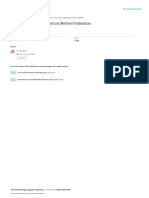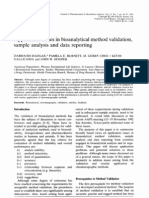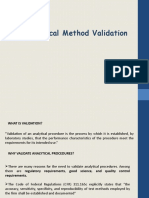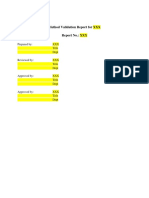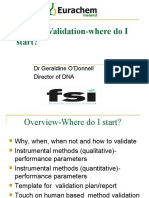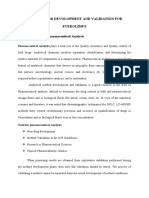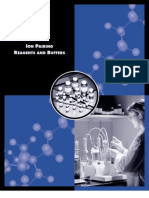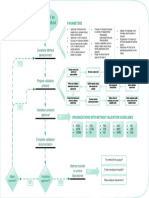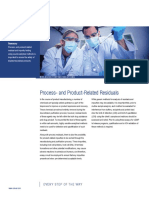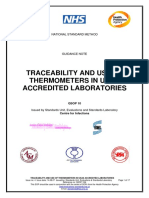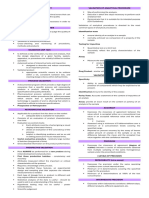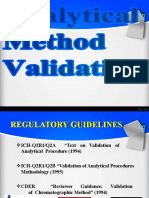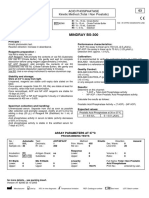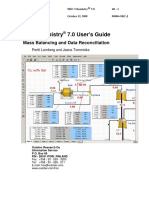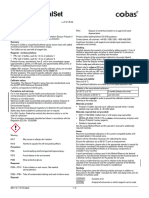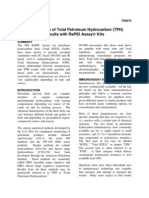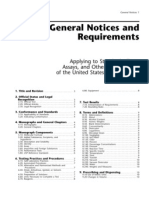Analytical Method Validation
1
QUALITY CONTROL FOR REGULATED ENVIRONMENTS
UNIVERSITY OF HOUSTON
�AMV: Why its important
2
Assays are fundamentally how we can see
biomolecules
Its commonly recognized that as soon as industries
could see the aspects of a product that affect
quality, they can measure it, and ultimately put
specifications for what is acceptable
Early example
Assays are a biochemical analogue to using our eyes
�Validation
3
Biological assays
Can be difficult to "validate"
"Validity" on a case by case basis
There can be relatively high levels of variability within the
assay
Biochemical assays are, generally, more variable than many
physical/chemical measurements
The validation of assays as you will see is quite
concerned with assay performance, including various
types of variability
�AMV
4
A broad range of analytical procedures are used to
document the quality of biotechnological derived
products.
The tests are exerted on several levels: raw materials,
in process control, drug substance, and final product
often based on methods from the US or European
Pharmacopoeia (the most common approach to
assay validation).
�AMV (contd)
5
It is an important aspect of quality assurance that the analytical
procedures are reliable and suitable for the intended use
Not only should the quality of raw materials, personnel, equipment,
and suppliers be assessed, but validation characteristics such as
Specificity
Linearity
Range
Accuracy
Precision
Detection limit
Quantification limit
Robustness
System suitability testing
should be considered for each analytical procedure.
�How much validation is needed?
6
In the initial phase of the project most analytical
procedures are undergoing development and validation
should be seen as an ongoing process throughout the
development program
For early clinical trials, the key concerns are safety,
potency and stability
Therefore, assays for those parameters should be
validated as soon as possible, even though the validation
must be of limited nature
The degree of validation also relates to the nature of the
analytical procedure (identity, impurity or assay)
�Pre-qualification requirements
7
Typical requirements associated to analytical method validation are listed
below.
Equipment
Equipment must be calibrated prior to use. A standard operation procedure and a log book
should be available.
Personnel
Personnel assigned to the validation should be adequately trained with respect to handling the
sample and reagents (safety) and use of equipment. Training records should be maintained
and competency should be documented.
Suppliers
It may be necessary to perform audits of specified suppliers.
Materials
Their quality, identity and composition must be certified.
Stability
The stability of the raw materials, reference standard and samples used must be documented.
�Some important steps in the method validation program
8
The analytical validation program depends on the procedure used. Typical issues
are listed below
Define the application purpose and scope of the method
Define the performance parameters and acceptance criteria
Define validation experiments
Verify relevant performance characteristics
Check the quality of raw materials used
Perform pre-validation parameters
Adjust method parameters and/or acceptance criteria, if necessary
Perform full validation experiment program
Develop standard operation procedures for executing the method
Define criteria for revalidation
Define type and frequency of system suitability tests and/or analytical quality
control checks
Document validation experiments and results in the validation report
�Analytical procedures
9
The most common types of analytical procedures are
identification tests, quantitative impurity tests, limit
tests and quantitative tests of active ingredient (drug
substance or product)
The identity tests are intended to ensure the identity of an
analyte in a sample
The impurity test can be either a quantitative test or a limit test
for the impurity in the sample
Assay procedures are intended to measure the analyte present
in a given sample
�10
The various
validation
characteristics that
should be applied to
analytical
procedures
(identification,
impurities, assays)
are summarized in
the ICH 2QA
document.
�Accuracy
11
The accuracy of an analytical procedure expresses
the closeness of agreement between the value which
is accepted either as a conventional true value or an
accepted reference value and the value found
The degree of agreement between the value found and a
reference value is sometimes termed trueness
�Accuracy (contd)
12
Several methods of determining the accuracy (assays) are available
An analyte of known purity can be applied to a analytical procedure or the results can be
compared to those of a second well characterized method, the accuracy of which is stated
or the accuracy may be inferred once precision, linearity and specificity have been
established
It may be impossible to obtain samples for all drug product components and it may be
acceptable either to add known quantities of the analyte to the drug product.
For impurities (quantitation), accuracy should be assessed on samples
spiked with known amounts of impurities or if such standards are not
available, it is considered acceptable to compare results obtained by an
independent procedure.
Accuracy should be assessed using a minimum of 9 determinations over a
minimum of 3 concentration levels covering the specified range
Accuracy should be reported as per cent recovery by the assay of known added amount of
analyte in the sample or as a difference in the mean and the accepted true value together
with the confidence intervals.
�Precision
13
The precision of an analytical procedure expresses
the closeness of agreement (degree of scatter)
between a series of measurements obtained from
multiple sampling of the same homogeneous sample
under the prescribed conditions.
The precision of an analytical procedure is usually
expressed as the variance, standard deviation or
coefficient of variation of a series of measurements.
�Precision Three Types
14
Repeatability
Repeatability expresses the precision under the same operating
conditions over a short interval of time. Repeatability is also
termed intra-assay precision .
Intermediate Precision
Intermediate precision expresses within-laboratories
variations: different days, different analysts, different
equipment, etc.
Reproducibilitiy
Reproducibility is an expression of precision between
laboratories.
�15
The precision of an analytical procedure is usually
expressed as the variance, standard deviation or
coefficient of variation of a series of measurements
The standard deviation, relative standard deviation
(coefficient of variation) and confidence interval
should be reported for each type of precision
investigated
�Relationship between accuracy and precision
16
Inaccurate &
imprecise
Inaccurate but
precise
Accurate but
imprecise
Accurate AND Precise
�Specificity
17
Specificity is the ability to assess unequivocally the analyte in
the presence of components which may be expected to be
present.
For assays, to provide an exact result which allows an accurate statement
on the content or potency of the analyte in a sample.
An identity test must be capable to discriminate between the
analyte (positive result) and compounds of closely related
structures (negative result), which are likely to be present
A challenge test with known compounds may be carried out.
Chromatographic procedures are often used to demonstrate
specificity in impurity tests provided sufficient resolution is
provided.
�Specificity (contd)
18
For non-chromatographic techniques, substitution of related
compounds can be used in spiking studies to show that the
results are unaffected by their presence
If impurity standards are not available for spiking studies,
specificity may be demonstrated by comparing the results of
tests of samples containing impurities or by reference to a
second well-characterized procedure (e.g. pharmacopoeial)
It is not always possible to demonstrate that an analytical
procedure is specific for a particular analyte
In this case a combination of two or more analytical
procedures is recommended to achieve the necessary level of
discrimination.
�Linearity
19
The linearity of an analytical procedure is its ability
(within a given range) to obtain test results which are
directly proportional to the concentration (amount)
of analyte in the sample.
Why is a linear relationship important?
A linear relationship should be evaluated by visual
inspection
If there is a linear relationship, test results should be evaluated
by appropriate statistical methods
Usually a minimum of five concentrations is needed for the
linearity determination.
�Range
20
The range of an analytical procedure is the interval
between the upper and lower concentration
(amounts) of analyte in the sample (including these
concentrations) for which it has been demonstrated
that the analytical procedure has a suitable level of
precision, accuracy and linearity.
What about outside of this range?
�Range (contd)
21
The specified range usually depends on the procedures application and is
derived from linearity studies
The minimum range for assay of drug substance/product is normally 80120% of the test concentration
For content uniformity a minimum range of 70-130% of the test
concentration is covered, unless a wider, more appropriate range is justified
For determination of an impurity the range is from the reporting level of the
impurity to 120% of the specification
For impurities know to be unusually potent or toxic the
detection/quantitation should be limited to commensurate with the level at
which the impurity should be controlled
For assays and impurity tests performed together as one test linearity should
cover a range from reporting level of impurities to 120% of the assay
specification.
�Detection limit
22
The detection limit of an individual analytical
procedure is the lowest amount of analyte in a
sample, which can be detected.
Detection limit applies to limit for test of impurities.
Approaches for determining the detection limit are
based on visual inspection, signal-to-noise, and
standard deviation of the response and the slope
The amount does not necessarily be quantified as an exact
value.
�Quantitation limit
23
The quantitation limit of an individual analytical
procedure is the lowest amount of analyte in a
sample, which can be quantitatively determined with
suitable precision and accuracy.
The quantitation limit applies for quantitation of
impurity tests
It is used particularly for the determination of impurities.
Approaches for determining the quantitation limit
are based on visual inspection, signal-to-noise, and
standard deviation of the response and the slope.
�Revalidation
24
Revalidation may be necessary if the manufacturing
process is changed, if the drug product composition
is changed or if the analytical method is changed
The degree of revalidation required depends on the
nature of changes
An essential function of change control is to assess
whether re-validation is necessary based on the
scope of the change








